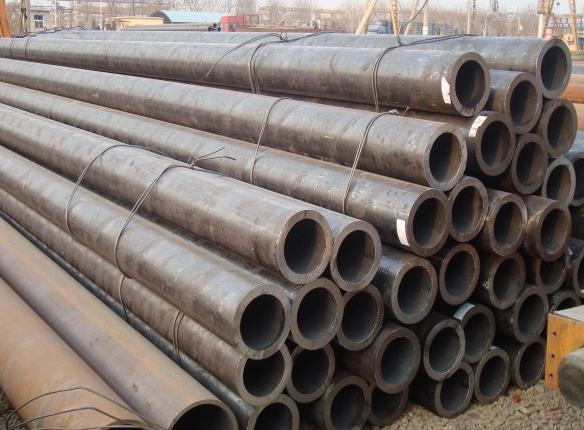Seamless Steel Pipe Manufacturing Process
Date:2024-04-08Tags:Seamless steel pipes, Seamless pipes, Seamless pipe, steel pipe
The seamless pipe is made of high-quality round steel as the main material, and then the round steel is perforated. The principle of perforation is to use high temperature to soften the round steel, and then use the plug to remove all the solid parts in the middle to become hollow round steel, that is, seamless steel pipe.

1. Manufacturing method of seamless pipe
According to different production methods, it can be divided into hot-rolled tubes, cold-rolled tubes, cold drawn seamless tubing, extruded tubes, etc.
(1) Hot-rolled seamless pipes are generally produced on automatic pipe rolling units. After checking and removing surface defects, the solid tube blank is cut into the required length, centered on the perforated end face of the tube blank, then sent to the heating furnace for heating, and pierced on the piercing machine. Spin and advance the solid blank inside the process of piercing holes under the influence with the roller as well as the end. Then the solid blank is hollow finally, which is called gross pipe. Send to the automatic pipe rolling machine to continue rolling. Finally, the wall thickness is adjusted by the equalizing machine, and the size is sized by the sizing machine to meet the specification requirements. It is a more advanced method to produce hot-rolled seamless steel pipes by using continuous rolling mills.
(2) If you want to obtain seamless pipes with smaller size and better quality, you must use cold rolling, cold drawing or a combination of the two. Cold rolling is usually carried out on a two-roll mill, and the steel pipe is rolled in an annular pass formed by a circular hole groove with variable cross-section and a stationary tapered plug. Cold drawing is usually carried out on a single-chain or double-chain cold drawing machine of 0.5-100T.
(3) The extrusion method is to place the heated tube blank in a closed extrusion cylinder, and the perforated rod and the extrusion rod move together to make the extruded part extrude from the smaller die hole. This method can produce steel pipes with smaller diameters.
2. Seamless steel pipe production process:
(1) Hot rolling (extruded seamless steel pipe): round tube billet → heating → piercing → three-roll cross rolling, continuous rolling or extrusion → tube removal → sizing (or reducing) → cooling → straightening →Hydrostatic test (or flaw detection) → marking → storage
(2) Cold drawn (rolled) seamless steel pipe: round tube blank→heating→perforation→heading→annealing→pickling→oiling (copper plating)→multi-pass cold drawing (cold rolling)→blank tube→heat treatment→Straightening→hydrostatic test (flaw detection)→marking→warehousing
Note:Detailed explanation of two steel pipe production processes
(1) Cold -pulled steel pipes are used as raw materials, and cold rolled rolled rolled rolled rolled rolled rolled rolled rolled rolled rolled rolled rolled rolled rolled rolling. Due to the cold and hardening caused by continuous cold deformation, the intensity, hardness increase, and tough plastic indicators of rolling rolling rolls will deteriorate, so stamping performance will deteriorate and can only be used for simple deformation parts. Rolling hard rolls can be used as raw materials for thermal galvanized factory, because the thermal galvanized units are equipped with annealing line. Rolling rolled rolled rolling weight is generally 6 ~ 13.5 tons, and the inner diameter of the steel roll is 610mm.
(2) The hot-rolled steel pipe uses continuous casting slabs or blooming slabs as raw materials, is heated by a walking heating furnace, and is descaled by high-pressure water before entering the rough rolling mill. The rough rolled material enters the finishing mill after cutting the head and tail, and implements computer-controlled rolling. After the final rolling, it goes through laminar flow cooling and coiling by the coiler to become a straight hair coil. The head and tail of straight hair curlers are often tongue-shaped and fish-tail-shaped, with poor thickness and width accuracy, and the edges often have defects such as wavy, hemmed, and tower-shaped. The coil weight is relatively heavy, and the inner diameter of the steel coil is 760mm. After the straight hair volume is processed by cutting the head, cutting the tail, trimming and multi-pass straightening, leveling and other finishing lines, it is then cut or re-rolled. That is to become: hot-rolled steel plate, flat hot-rolled steel coil, slitting strip and other products. If the hot-rolled finishing coils are pickled to remove scale and oiled, they will become hot-rolled pickled coils.
Production Processes of Petroleum Seamless Steel Pipes
Seamless steel pipes are essential for high-pressure, high-temperature pipelines in oil and gas extraction, transportation, and processing. Their production involves three main methods: continuous rolling, cyclic rolling, and three-roll pipe production, each catering to different needs.
1. Continuous Rolling
This efficient method is ideal for producing pipes with diameters under 168 mm.
Process: Heated round billets are pierced, rolled with a mandrel through a continuous mill, reheated, and tension-reduced to achieve precise dimensions.
Advantages: High efficiency and large-scale production.
Challenges: Requires significant equipment investment.
2. Cyclic Rolling
Best for large-diameter, thick-walled pipes.
Process: Heated steel ingots are pierced, elongated, and rolled in periodic mills with variable-diameter slots.
Advantages: High efficiency for specialized pipes.
Challenges: Complex equipment.
3. Three-Roll Rolling
Designed for precision thick-walled pipes.
Process: A three-roll cross-rolling machine adjusts angles to enhance accuracy and eliminate defects.
Advantages: Wall thickness accuracy of ±5%.
Conclusion
These methods enable the production of seamless steel pipes tailored to meet stringent industrial demands, ensuring reliability in energy transmission systems.






 English
English Español
Español بالعربية
بالعربية











 Phone :
Phone :  Whatsapp :
Whatsapp :  Email :
Email : 


